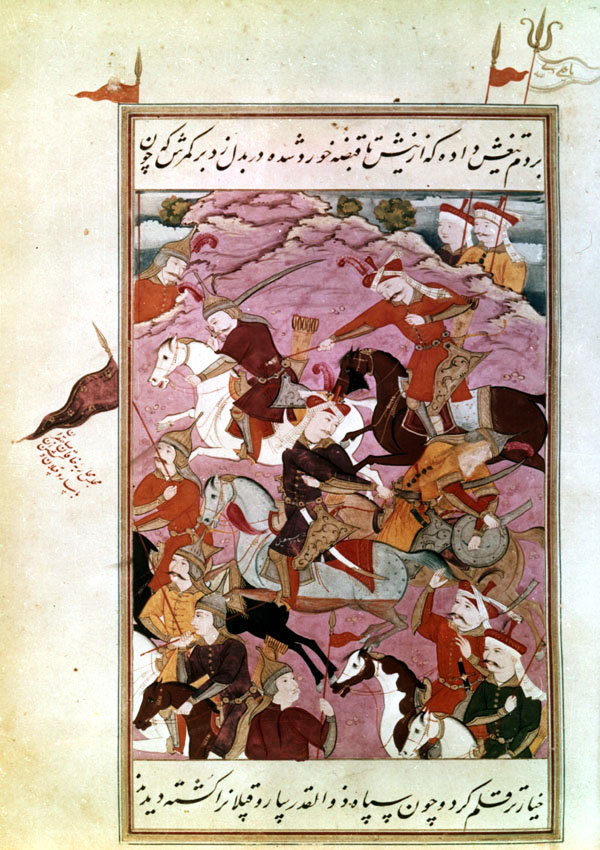Battle Scene Between Ẕuʾl-Qadars and Safavids in which Sāru Qaplān is Killed
This painting is problematic in several respects. Firstly, the location in Muntazar’s text conforms to the dating advanced by Monshi - the winter of 913/1507-8 - yet this folio precedes by seven folios an event from 908/1503 (cf. folio 94v). It would seem that either these two folios were mis-cataloged by Mahboubian, or inverted when the Tehran manuscript was rebound. In order to resolve this issue one needs access to the complete Tehran text. Secondly, the subject is listed by Mahboubian as Shah Esmāʿil, in Battle with Sāru Qaplān, Kills Him, an identification presumably derived from the red marginal inscription. According to Monshi in the ʿĀlam ārā-ye ʿAbbāsi, in the winter of 913/1507-8, ʿAlā al-Dowla Ẕuʾl-Qadar (see folio 42v) sent 2000 men under the command of two sons, Qāsem Beg, known as Sāru Qaplān, and Orduvāna Beg, to Diār Bakr against the qezelbāš commanded by Khan Moḥammad ʿOstājlu. Both brothers and a considerable number of Ẕuʾl-Qadars were captured and put to death. Dismayed by the fate of his sons, ʿAlā al-Dowla mobilized 15,000 men under the command of two other sons, Kur Šāhroḵ and Aḥmad Beg, to engage Khan Moḥammad. The two opposing forces fought at Āmeda, also known as Qarā Ḥamid (see Ms. L, folio 137), where these two sons of ʿAlā al-Dowla were also slain on the battlefield.
The tāriḵ-e ʿālām-ārā-ye šāh esmāʿil states that in the first engagement the Ẕuʾl-Qadar forces were commanded by Sāru Qaplān and Sāru Aslān, not Orduvāna Beg as cited by Monshi. And in the battle it was Qarā Ḵān, the brother of Khan Moḥammad ʿOstājlu, who actually killed both of these sons of ʿAlā al-Dowla in battle. It agrees that the second engagement took place at Qarā Ḥamid, but that the Ẕuʾl-Qadar forces numbered 30,000, twice as many as cited by Monshi, and they were under the command of Orduvāna Beg and Kur Šāhroḵ. Khan Moḥammad ʿOstājlu was not present at this battle, but his brother Qarā Ḵān, who had been left in charge, walled himself up inside the fortress of Qarā Ḥamid. By dropping flaming oil and missiles from atop the walls they were able to burn or kill 15,000 of the attackers. Orduvāna Beg was burned, and the remaining son Kur Šāhroḵ sent a request to his father for additional help. 20,000 Ẕuʾl-Qadar reinforcements arrived under the command of a fifth son, Khan Moḥammad, which coincided with the return of Khan Moḥammad ʿOstājlu and the main force of Safavids. See Ms. L, folio 137 for an account of the third engagement between qezelbāš and Ẕuʾl-Qadars. Both texts agree: Shah Esmāʿil was not personally engaged in any of the battles between the Safavids and Ẕuʾl-Qadars. Yet the marginal inscriptions on this folio identifies the dominant Safavid personage as Shah Esmāʿil, and the Ẕuʾl-Qadar being killed as Sāru Qaplān. These identifications appear to be erroneous, for the text clearly states that it was Qarā Ḵān, brother of Khan Moḥammad ʿOstājlu, that killed Sāru Qaplān. It is uncertain but it is likely that Moʿin was portraying Qarā Ḵān, not Shah Esmāʿil.
All total six Safavids, seven Ẕuʾl-Qadars, and eight horses are represented. Qarā Ḵān (identified in the inscription as Shāh Esmāʿil), wearing a purple tunic and seated on a light gray charger, occupies central position. He turns to the rear, and thrusts a sword through Sāru Qaplān, who slumps off his horse. Except for an individual combat behind them, the remaining personage either observe the proceedings, or quietly leave the scene lance in hand. The battle is set against a hill of light mauve, with small patches of blue sky and suggestions of foliage at the top.
Location: Reza Abbasi Museum, Tehran, No.77.1.7, folio 87?
Folio size: 35.6 x 21.6 cm. wide (after Mahboubian)
Painting: 24.1 x 16.8 cm. wide including standards in upper and left margins (after Mahboubian). Sāru Qaplān’s face is damaged.
Written surface: 22.5 cm. (scaled) x 13.1 cm. wide.
Inscriptions: A marginal inscription in red describes the event. Inscriptions on two of the figures, incorrectly identify one as šāh esmāʿil and the other as sāru qaplān.
Painting references:
Mahboubian_1972, #923 folio 87 (not illustrated).
Text references:
See Muntaẓer-Ṣāḥeb_1970, p.219 for this event in the History of Shah Esmāʿil.
See Savory, SA_1979, p.52 for this event in the History of Shah ʿĀbbās.
Robert Eng
Last Updated: Dec. 13, 2011 | Previous Update: Dec 7, 2010 | Originally published: March 28, 2002
